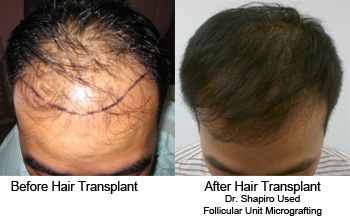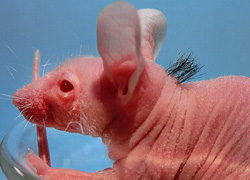 New research may lead to a topical medication could delay male pattern balding, also called androgenetic alopecia. The research was conducted by L’Oreal in Paris, and it looked closely at hair follicles and stem cells that cause hair to grow. They hope to one day develop a cream or shampoo that staves off the male pattern balding by encouraging hair to “wake up” from its domancy phase.
New research may lead to a topical medication could delay male pattern balding, also called androgenetic alopecia. The research was conducted by L’Oreal in Paris, and it looked closely at hair follicles and stem cells that cause hair to grow. They hope to one day develop a cream or shampoo that staves off the male pattern balding by encouraging hair to “wake up” from its domancy phase.
The hair growth cycle has three phases: anagen, catagen and telogen. The anagen phase is when the follicle creates a hair, and the hair grows for several years. The hair follicle begins to shrink in the catagen phase, and the hair falls out. The follicle becomes dormant in the telogen phase for several months. Then the cycle starts over.
In male pattern balding, however, the follicles in areas sensitive to hormones get smaller and smaller, producing thinner, smaller hair. Eventually, the follicle stops producing a hair and remains in the telogen phase forever.
Continue reading →
 You may have heard the term follicular unit micrografting while researching hair transplants, but what is it? Is it technobabble and marketing speak, or a distinct technique for successful hair transplants?
You may have heard the term follicular unit micrografting while researching hair transplants, but what is it? Is it technobabble and marketing speak, or a distinct technique for successful hair transplants? New research may lead to a topical medication could delay male pattern balding, also called androgenetic alopecia. The research was conducted by L’Oreal in Paris, and it looked closely at hair follicles and stem cells that cause hair to grow. They hope to one day develop a cream or shampoo that staves off the male pattern balding by encouraging hair to “wake up” from its domancy phase.
New research may lead to a topical medication could delay male pattern balding, also called androgenetic alopecia. The research was conducted by L’Oreal in Paris, and it looked closely at hair follicles and stem cells that cause hair to grow. They hope to one day develop a cream or shampoo that staves off the male pattern balding by encouraging hair to “wake up” from its domancy phase. Your head is itchy and flaking. Small balding patches are showing up on your scalp. Your hair always looks dirty, and you can’t wear black anymore. And you’re trying one dandruff shampoo after another. Is this a simple case of dandruff, or is it something more serious?
Your head is itchy and flaking. Small balding patches are showing up on your scalp. Your hair always looks dirty, and you can’t wear black anymore. And you’re trying one dandruff shampoo after another. Is this a simple case of dandruff, or is it something more serious?
 A key protein that causes male pattern balding has been identified by researchers. This could lead to hair loss treatments that stop balding, and maybe even reverse it.
A key protein that causes male pattern balding has been identified by researchers. This could lead to hair loss treatments that stop balding, and maybe even reverse it.